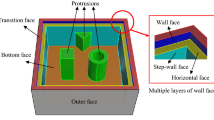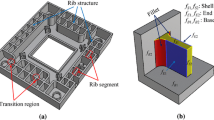Abstract
Thin-wall plastic parts exist in many products and are frequently manufactured by injection molding. The inner surface of a thin-wall part has many functional and structural features, typically divided into depressions and protrusions. While recognition of protrusion features is important in mold flow analysis, this recognition is difficult owing to the complexity and variety of the designed shapes. The purpose of this study was to develop a method for the detection and classification of protrusion features on thin-wall plastic parts. In the proposed algorithm, the inner and outer faces of a part model were detected first. Auxiliary faces, including translational, wall, and bottom faces, were recognized next. With auxiliary faces available, protrusion faces can thus be recognized and grouped in accordance with their neighboring relationship. A feature classification algorithm was finally implemented to classify five types of protrusions, namely tubes, ribs, columns, polygon blocks, and irregular extrusions. A detailed description of the procedures in each step of the proposed algorithm is provided. Twelve CAD models and analysis results are also presented to demonstrate the feasibility of the proposed protrusion recognition algorithm.


















Similar content being viewed by others
References
Lim T, Medellin H, Torres-Sanchez C, Corney JR, Ritchie JM, Davies JBC (2005) Edge-based identification of DP-features on free-form solids. IEEE Trans Pattern Anal Mach Intell 27:851–860
Zhang CJ, Zhou XH, Li CX (2009) Automatic recognition of intersecting features of freeform sheet metal parts. J Zhejiang Univ Sci A 10:1439–1449
Li B, Liu J (2002) Detail feature recognition and decomposition in solid model. Comput Aided Des 34:405–414
Chong CS, Kuma AS, Lee KH (2004) Automatic solid decomposition and reduction for non-manifold geometric model generation. Comput Aided Des 36:1357–1369
Joshi S, Chang TC (1988) Graph-based heuristics for recognition of machined features from a 3D solid model. Comput Aided Des 20:58–66
Ismail N, Bakar NA, Juri AH (2004) Recognition of cylindrical-based features using edge boundary technique for integrated manufacturing. Robot Comput Integr Manuf 20(5):417–422
Ismail N, Bakar NA, Juri AH (2005) Recognition of cylindrical and conical features using edge boundary classification. Int J Mach Tools Manuf 45(6):649–655
Sheen DP, Son TG, Myung DK, Lee SH, Lee K, Yeo TJ (2010) Transformation of a thin-walled solid model into a surface model via solid deflation. Comput Aided Des 42:720–730
Nolan DC, Tierney CM, Armstrong CG, Robinson TT, Makem JE (2014) Automatic dimensional reduction and meshing of stiffened thin-wall structures. Eng Comput 30(4):689–701
Sun L, Tierney CM, Armstrong CG, Robinson TT (2016) Automatic decomposition of complex thin walled CAD models for hexahedral dominant meshing. Procedia Eng 163:225–237
Morgut M, Nobile E (2009) Comparison of hexa-structured and hybrid-unstructured meshing approaches for numerical prediction of the flow around marine propellers. In: First international symposium on marine propulsors, Trondheim, Norway
Lu Y, Li YG (2009) Feature recognition technology of complex structural parts based on re-extended attributed adjacency graph. Mach Des Manuf 219:240–242
Lai JY, Wang MH, Song PP, Hsu CH, Tsai YC (2018) Automatic recognition and decomposition of rib features in thin-shell parts for mold flow analysis. Eng Comput 34(4):801–820
Wang MH, Lai JY, Hsu CH, Tsai YC, Huang CY (2016) Boss recognition algorithm and application to finite element analysis. Comput Aided Des Appl 14(4):450–463
Fu MW, Nee AYC, Fuh JYH (2002) The application of surface visibility and moldability to parting line generation. Comput Aided Des 34(6):469–480
Rhinoceros. http://www.rhino3d.com. Accessed 6 July 2017
openNURBS. http://www.rhino3d.com/tw/opennurbs. Accessed 6 July 2017
CADdoctor. http://elysiuminc.com/products/caddoctor. Accessed 6 July 2017
Author information
Authors and Affiliations
Corresponding author
Additional information
Publisher's Note
Springer Nature remains neutral with regard to jurisdictional claims in published maps and institutional affiliations.
Rights and permissions
About this article
Cite this article
Lai, JY., Song, PP., Hsiao, AS. et al. Recognition and classification of protrusion features on thin-wall parts for mold flow analysis. Engineering with Computers 37, 833–854 (2021). https://doi.org/10.1007/s00366-019-00859-1
Received:
Accepted:
Published:
Issue Date:
DOI: https://doi.org/10.1007/s00366-019-00859-1




